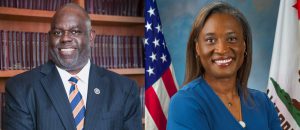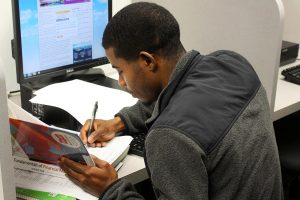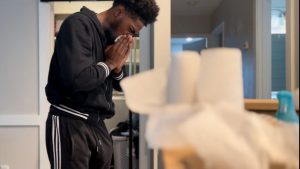
Diamond Jenkins
Blue & White Flash / Associate Editor
From the pink water in the fountains in front of the H.T. Sampson Library to a “Pretty in Pink” seminar held in Campbell College South residence hall, a number of activities at Jackson State University have focused attention on October as Breast Cancer Awareness Month.
Other awareness events included an annual conference presented by a breast cancer survivor, a collection of bras to be donated to a local breast cancer charity, and members of the JSU Queen’s Court providing information bags and going door to door in the freshman residence hall.
According to the United Nations World Health Organization, approximately 500,000 people worldwide die from breast cancer every year.
Odessa Hawkins, an 8-year breast cancer survivor and a nurse practitioner at the JSU Student Health Center who led the recent seminar, advised that women should begin getting mammograms at age 40 once every three years. Women over the age of 40 and women with a history of breast cancer in their family should be checked every year. She spent time explaining in detail how women should do a breast self-exam, and urged the young women to tell their doctor if they feel anything outside of the ordinary.
To reinforce her point, Hawkins also had a breast model display set up with three different sizes of breast tissues where students were able to give breast exams to detect any lumps within the breast. One of the major reasons self-breast exams are so important may have to do with the fact that approximately 40 percent of women who undergo screening, a disproportionate number of which are black, have dense breasts, experts say. In contrast with less-dense breasts, which have a high amount of fatty tissue, dense breasts have a high amount of connective and glandular, or fibroglandular, tissue that appears as solid white areas on a mammogram, just as tumors do.
“Women should have their mammograms done along with doing their self-breast exams because mammograms along with a trained hand can detect a tiny lump easier and can start treatment earlier if the lump is cancerous to beat breast cancer,” stated Hawkins.
Chastity Curry, a sophomore meteorology major from Atwood, Tenn. who attended the seminar said: “I learned the proper way to give a self-breast exam and the correct timing of when I should get a mammogram.”
Members of Miss JSU’s Queens’ Court conducted an informational dorm walk last week.
“We made bags with information about breast cancer awareness and how to correctly perform self screenings. We knocked on doors and gave the information to the girls and also explained the importance of going to get annuals and regular check ups at the clinic on campus,” said Miss Freshman Robin Jackson from Jackson, Miss.
The Jackson State University College of Education and Department of Human Development joined national public service organizations, professional medical associations, and government agencies in its efforts to promote breast cancer awareness at its 6th Annual Breast Cancer Awareness Conference held Oct. 8-10.
The event, held at the Mississippi e-Center, provided information on the disease and access to services along with providing testimonials from breast cancer survivors. The Breast Cancer Walk-for-a-Cure was also a part of the conference.
Interim Chair and Associate Professor of Special Education Ruby Wiggins, an 11 year breast cancer survivor had the idea to start the breast cancer awareness conference six years ago as a way to present information and share different perspective on diagnosis and treatment of breast cancer.
JSU students who attended the conference believe that college students should be more aware of the deadly ramifications of breast cancer.
Ashley Terrell, a junior computer technology major from Baltimore, Md., said, “I am currently an American Cancer Society Cancer Action Network advocate for my hometown in Maryland and I believe that college students can have a tremendous influence on the cancer movement if they choose to get involved.”
Patrick Washington, a healthcare administration major from St. Louis, Mo., agreed.
“I think that college students especially need to get involved in awareness because we’re going to be the next generation of researchers, of doctors and then of patients even,” said Washington. “We’re going to be the ones that are going to see the change that’s going to happen when new cancer drugs are made.”
One of the organizations that brings information to college students about breast cancer and prevention is the Susan G. Komen for the Cure Foundation. This year, their annual bus tour is scheduled to visit Jackson State on first Nov. 8, 2012.
According to ww5.komen.org, Rates of breast cancer vary among different groups of people. Rates vary between women and men and among people of different ethnicities and ages. They vary around the world and across the United States. This section provides an overview of breast cancer statistics for many populations.
In 2012, it is estimated that among U.S. women there will be:
226,870 new cases of invasive breast cancer (includes new cases of primary breast cancer among survivors, but not recurrence of original breast cancer among survivors).
63,300 new cases of in situ breast cancer. DCIS is a non-invasive breast cancer and LCIS is a condition that increases the risk of invasive breast cancer. Learn more about DCIS and LCIS.
39,510 breast cancer deaths.
Breast cancer in men is rare, but it does happen. In 2012, it is estimated that among U.S. men there will be:
2,190 new cases of breast cancer.
410 breast cancer deaths. :
Men are usually diagnosed at a later stage because they are less likely to report symptoms.
Treatment for men is the same as treatment for women and usually includes a combination of surgery, radiation, chemotherapy, hormone therapy and/or targeted therapy.




Be First to Comment